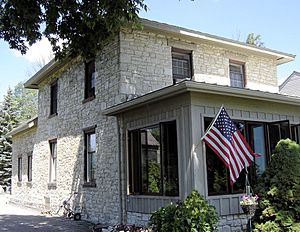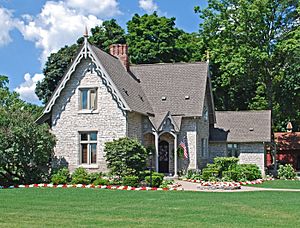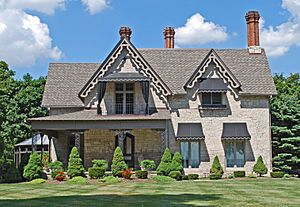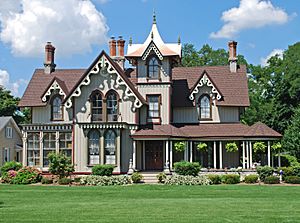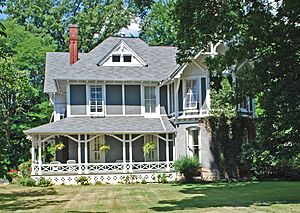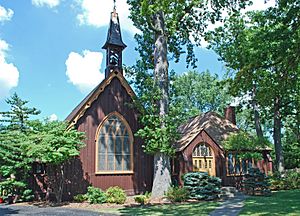East River Road Historic District facts for kids
|
East River Road Historic District
|
|

Gothic Revival "Wedding Cake House" on East River Road
|
|
| Location | E. River Rd., Grosse Ile, Michigan |
|---|---|
| Area | 18 acres (7.3 ha) |
| Architect | Gordon W. Lloyd |
| Architectural style | Gothic Revival, Swiss Chalet |
| NRHP reference No. | 74001003 |
Quick facts for kids Significant dates |
|
| Added to NRHP | August 13, 1974 |
The East River Road Historic District is a special area in Grosse Ile, Michigan. It's located along East River Road, near the Grosse Ile Parkway. This district has eleven important buildings. You'll find seven houses, two smaller buildings, a church called St. James Episcopal Church, and an old train station.
The district stretches from the church in the south to a house called Littlecote in the north. It became a Michigan State Historic Site in 1972. Then, in 1973, it was added to the National Register of Historic Places. This means it's a very important historical place! An old customs house from the 1870s was moved here in 1979. It's also part of the district's history.
Contents
Historic Homes of East River Road
Many of the homes in this district were built between 1840 and 1870. A famous architect named Gordon W. Lloyd designed many of them. These houses are all on East River Road. They face the Detroit River and have big yards with nice views.
They are mostly in the Gothic Revival or Swiss Chalet styles. They are built from limestone or wood. Many have fancy decorations called "gingerbreading." These homes were built for rich families from Detroit. They wanted a clean and quiet place to spend their summers. The island was a great escape from the busy city.
Lloyd's designs helped make the island beautiful. This made it a popular spot for important Detroit families in the 1800s. The people who lived here and the architects were inspired by Andrew Jackson Downing. He wrote books like Cottage Residences and The Architecture of Country Houses.
Here are some of these special houses:
Dallas Norvell House
This house was built in 1851. It was made for Dallas Norvell. The stone came from a quarry right on Grosse Ile. Dallas Norvell was the son of John Norvell, a U.S. Senator from Michigan.
Dallas Norvell was born in 1825 in Philadelphia, Pennsylvania. He went to the University of Michigan. Later, he became a farmer on Grosse Ile. He also served as a leader for Monguagon Township for many years. He was also a Deputy Postmaster in Detroit. Around 1870, he moved to Canada. He felt Grosse Ile was getting too crowded with people from Detroit.
Samuel T. Douglass House (Littlecote)
This house is also known as "Littlecote." It was built in 1859 for Judge Samuel T Douglass and his wife Elizabeth Campbell Douglass. It's a Gothic Revival cottage. Gordon W. Lloyd designed this house too.
The house is made of gray stone. It has a decorative chimney and unique gables. It also has many porches and a special oriel window.
Anthony Dudgeon House
The Anthony Dudgeon House was built in 1859. It is another Gothic Revival building. Gordon W. Lloyd also designed this one. A shipping leader named William Livingstone later lived here. He called the house "Rio Vista."
Samuel Lewis House (The Wedding Cake House)
This house was built in 1859 for Samuel Lewis. He was a well-known banker in Detroit. It is one of the best examples of a Gothic Revival villa in Michigan. The house is made of brick. It has a wooden exterior that looks like board and batten.
It has a fancy chimney and decorative gables. There is also a large veranda. It was once called "The Lilacs" because of a lilac hedge. Now, it's known as "the Wedding Cake House." After Lewis, Detroit mayor Kirkland C. Barker lived here. Then it went to Frank Osburn. This house has never been changed or updated.
Frederick Anderson House
This house was built in 1881. It was for Dr. Frederick Pope Anderson and his wife Mary Campbell Douglass. Mary was the daughter of Samuel T Douglass. It's a Victorian house in the stick style. It even has a secret passage and a hidden bedroom!
St. James Episcopal Church
St. James Episcopal Church was built mostly with money from Lisette Denison Forth. She was a former slave. Lisette had worked for Detroit mayor John Biddle and his wife Eliza. Lisette and Eliza were friends. They both shared the Episcopalian faith. They promised each other they would build a church one day.
When Lisette Forth passed away, she left most of her money, about $3000, to build a church. Eliza Biddle's son, William, knew his mother's wish. He added his own money and some of his mother's money to Lisette's gift. William's brother, James, gave the land for the church. The brothers hired architect Gordon W. Lloyd to design it.
The church is a Carpenter Gothic style building. Its walls are made of vertical boards. The gables have decorative bargeboards. The entrance is on one side, and a steeple is on top. The church has beautiful stained glass windows. One is an 1898 Tiffany window called Angel of Praise. It is very large, about 11 feet by five-and-a-half feet.
Over the years, the church has had some repairs and additions. But the main part of the building is still original. It is in excellent condition. The red doors of the church are dedicated to Lisette Denison Forth. They remember her kindness and generosity.
Michigan Central Railroad Depot
| Grosse Ile Depot, Canada Southern / Michigan Central Railroad Depot | |
|---|---|

Michigan Central Railroad Depot, 2010
|
|
| Built | 1904 |
| Designated | May 20, 1982 |
In 1873, the Canada Southern Railway started a freight system on Grosse Ile. They used ferries to bring goods and people from Amherstburg, Ontario to Stony Island. Then, trains carried them across Grosse Ile to the mainland. The train tracks were where the Grosse Ile Parkway is today.
Canada Southern built a passenger station and other buildings on Grosse Ile. They bought the land from Isabella Hodgkiss Freeman Norvell. She was the widow of Senator John Norvell, and her son was Dallas Norvell. However, the railroad soon had money problems. Around 1880, the Michigan Central Railroad bought Canada Southern.
Michigan Central already had a ferry service in Detroit. So, they stopped the ferry service in Grosse Ile. But more and more wealthy people were moving to Grosse Ile. So, the railroad increased its passenger service. They ran up to three round trips from Detroit to Grosse Ile.
In 1904, the Michigan Central Railroad built this new depot. It replaced an older wooden building. The depot is made of yellow brick. It has red brick details around the windows and at the corners, called quoins. Since 1967, the Grosse Ile Historical Society has used this depot. The station is on land that once belonged to Isabella Hodgkiss Norvell.
U.S. Customs House
| U.S. Customs House | |
|---|---|
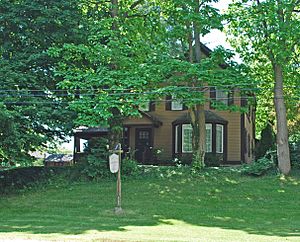
U.S. Customs House, 2010
|
|
| Built | 1871 |
| Designated | May 20, 1982 |
The Customs House was built in 1871. It was originally at 7799 Macomb Street. It was used for the ferry and freight line built by Canada Southern Railway. When freight traffic stopped, the customs house closed in 1883.
The building later became Grosse Ile's first post office. In 1904, it was turned into a private house. In 1979, it was fixed up and moved to its current spot behind the depot. The Customs House was named a Michigan State Historic Site in 1982. The Grosse Ile Historical Society uses the building today.




